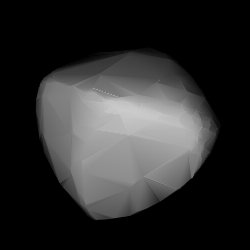 Shape model of Alcock from its lightcurve | |
| Discovery [1] | |
|---|---|
| Discovered by | E. Bowell |
| Discovery site | Anderson Mesa Stn. |
| Discovery date | 26 October 1984 |
| Designations | |
| (3174) Alcock | |
Named after | George Alcock (amateur astronomer) [2] |
| 1984 UV ·1962 YD 1969 BB ·1973 YO1 1975 EO3 ·1978 RB1 1978 TJ3 ·1979 YR8 1980 AH ·1981 GF | |
| main-belt · Themis [3] | |
| Orbital characteristics [1] | |
| Epoch 4 September 2017 (JD 2458000.5) | |
| Uncertainty parameter 0 | |
| Observation arc | 47.71 yr (17,426 days) |
| Aphelion | 3.6932 AU |
| Perihelion | 2.5991 AU |
| 3.1462 AU | |
| Eccentricity | 0.1739 |
| 5.58 yr (2,038 days) | |
| 296.20° | |
| 0° 10m 35.76s / day | |
| Inclination | 2.3715° |
| 72.244° | |
| 4.6082° | |
| Physical characteristics | |
| 18.66±0.80 km [4] 18.71 km (calculated) [3] | |
| 7.05±0.01 h [5] | |
| 0.08 (assumed) [3] 0.102±0.009 [4] | |
| C (assumed) [3] | |
| 12.0 [1] [3] ·11.80 [4] | |
3174 Alcock (prov. designation: 1984 UV) is a carbonaceous Themistian asteroid from the outer region of the asteroid belt. It was discovered by American astronomer Edward Bowell at Lowell's U.S. Anderson Mesa Station in Flagstaff, Arizona, on 26 October 1984. [6] The likely C-type asteroid has a rotation period of 7.1 hours and measures approximately 19 kilometers (12 miles) in diameter. It was named after British amateur astronomer George Alcock (1912–2000).